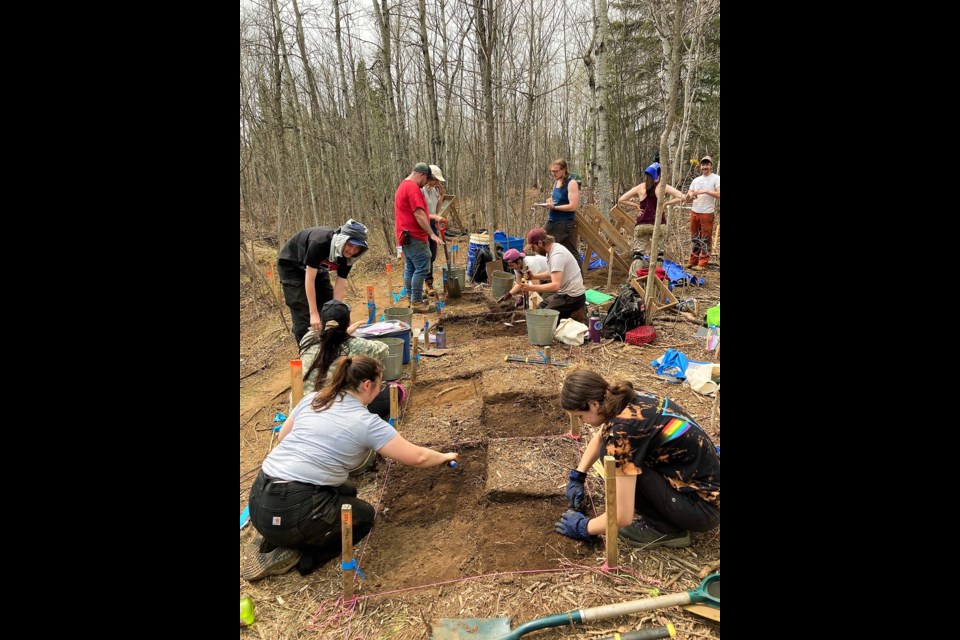THUNDER BAY – A site along the banks of the McIntyre River on Lakehead University’s campus is offering rare glimpses into the daily lives of Indigenous peoples who inhabited the area around 4,000 years ago.
Researchers in the school’s anthropology department have been leading excavation work at dig sites along the river, turning up stone tools and other items that help reveal new details of the region’s ancient history.
The project has allowed students to develop crucial field work skills just a few minutes’ walk from their classroom.
“We have the opportunity with this class to show how to properly excavate, and that’s something we don’t get to do very often,” said Jill Taylor-Hollings, a research associate in the department of anthropology
“Only a few of the students had [field work] experience before this. We’re hoping this will lead to more archaeologists coming into the area and staying [here], because we have a real shortage.”
That’s important in order to ensure the huge number of archaeologically significant sites in the area are properly reviewed and protected when development occurs, she said.
The Lakehead sites, now kilometres removed from Lake Superior, would have been near the shoreline of a larger lake during the time in question. It's an area where Indigenous peoples long camped, hunted, and created tools.
The sites offer rare glimpses into how those inhabitants lived, traded, and used technology during an era that's less well-documented by research, said Taylor-Hollings, noting it’s more common in the Thunder Bay area to find older sites that can date back around 9,000 years.
“What we call the middle period, which ranges from about 7,000 until 3,000 years ago – we don’t really understand that period very well,” she said. “So we’re very excited to be working at these sites to learn more about the ancient people who were there.”
“It’s really amazing to actually see where these campsites were, right in the landscape, still preserved.”
Researchers have found ancient fire pits and evidence that people visited the area to find local lithic material for tool-making, and acquired materials sourced from elsewhere across the continent.
The site is located on the traditional territory of Fort William First Nation, which gave its permission for the work and will share in the research results.
At the time, 4,000 or more years ago, Taylor-Hollings said the lands are believed to have been occupied by Algonquian-speaking peoples who are likely the ancestors of people living today in Fort William First Nation.
“It’s very important for Indigenous communities to know more about this history and to have that available to share with people, so they can learn more about their ancient ancestors,” she said.
Students who participated in the program described it as an amazing learning opportunity that offered crucial experience, and a deeper knowledge of the Thunder Bay area.
“I love being able to pick up a flake that hasn’t been touched by another human in thousands and thousands of years,” said second-year student Carli Muloin, who made her first visit to a dig site with the program.
“It’s really neat to see how people were occupying that site even that far back.”
Meilan Dowling, an anthropology student heading into her fourth year, was among the first students to find an artifact at the site, locating a taconite core that would have been chipped into smaller pieces for tool-making using smooth rocks or antlers.
“We felt very lucky,” she said. “We knew there was something to find, but I didn’t expect for my first actual dig to be the first person to find something.”
“We just hit something and thought, oh that’s a rock – but could it be a cool rock, that’s the question? And it was.”
She said the project helped her appreciate the sophistication of the technology used at the time.
“It’s very hard,” she said of the ancient tool-making process, which she tried her own hand at in workshops.
“That’s one of the things they say in this class – people may think stone tool technology is primitive, but it was so intricate to actually make… I think it’s very interesting for people in the modern day to realize.”
The project also served as a training ground this week for those enrolled in the Indigenous Archaeological Technician training program, which will prepare members of regional Indigenous communities to conduct archaeological review of sites impacted by the Waasigan Transmission Line project.
The anthropology department also partnered with Lakehead’s Niijii Indigenous Mentorship Program and Parks Canada on the project.
